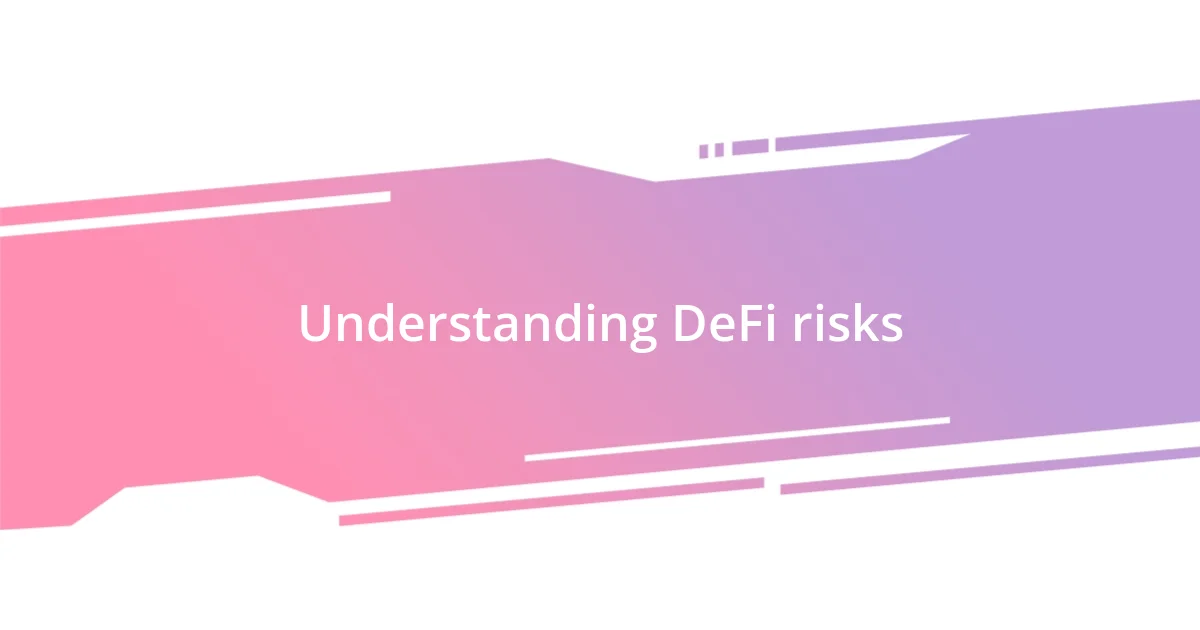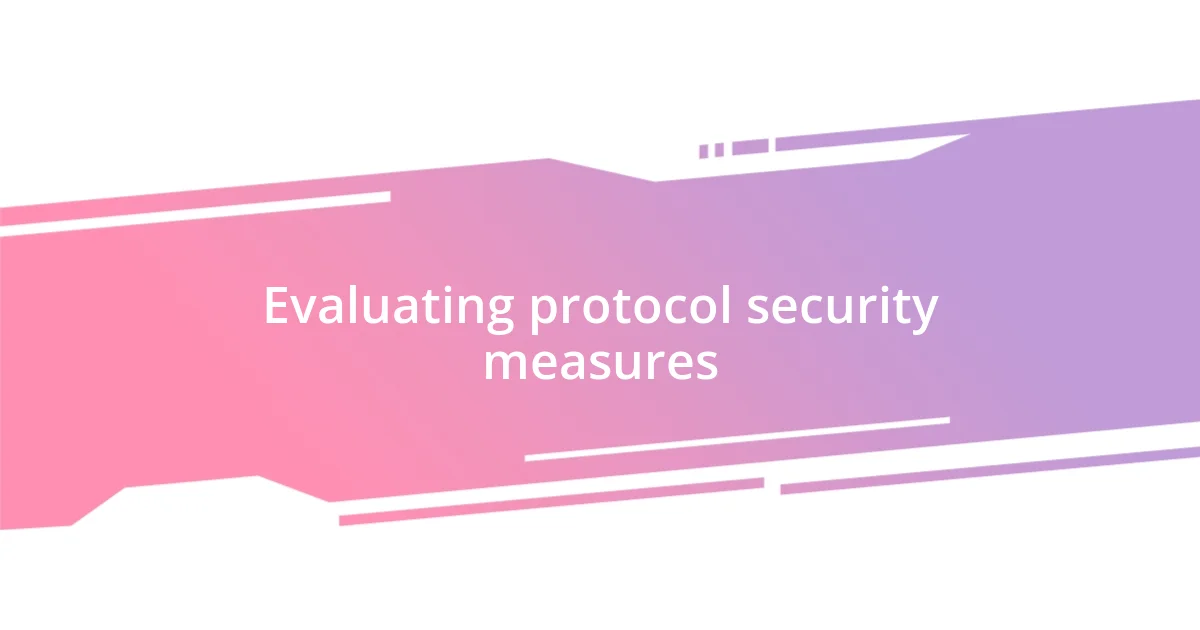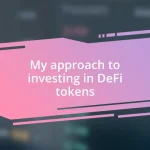Key takeaways:
- Recognizing and evaluating DeFi risks—such as smart contract vulnerabilities, price volatility, and lack of regulation—is crucial for informed investment decisions.
- Diversifying investments across different DeFi projects and regions not only mitigates risk but also provides multiple income streams, enhancing overall portfolio stability.
- Engaging with the DeFi community and utilizing risk management strategies, such as setting limits on investments and using stop-loss orders, are essential for navigating the rapidly changing landscape.

Understanding DeFi risks
Diving into DeFi can feel like stepping into a thrilling adventure, but it’s vital to recognize the risks involved. From smart contract vulnerabilities to liquidity issues, each aspect carries its own set of potential pitfalls. I remember one instance where I hesitated to invest in a project because I noticed a significant flaw in their code—a decision that ultimately saved me from a substantial loss.
One of the most daunting risks I’ve faced is the price volatility of assets. Just a few months ago, I watched in disbelief as the value of a token I held plummeted overnight. It’s moments like these that make you question your risk tolerance and strategy. Have you ever felt that sinking feeling when your investment suddenly takes a nosedive?
Additionally, the lack of regulatory oversight in DeFi adds another layer of complexity. I often ask myself how comfortable I am navigating a space where rules are still being defined. The thrill of innovation is enticing, but balancing that excitement with caution has been a key lesson in my DeFi journey.

Identifying common DeFi threats
When delving into DeFi, I’ve found that identifying common threats is essential for safeguarding my investments. Each challenge can catch you off guard if you’re not vigilant. I distinctly remember a project that promised incredible returns, but a quick scan of their activity revealed an alarming number of exploits. It was a simple reminder: if something seems too good to be true, it probably is.
Here are some prevalent threats I look out for:
- Smart contract vulnerabilities: Bugs in code can lead to significant financial losses.
- Rug pulls: Scammers may create a project, attract investment, then disappear with the funds.
- Price manipulation: Market players can influence asset prices, creating unpredictable environments.
- Impermanent loss: Changes in asset prices can negatively affect liquidity providers in decentralized exchanges.
- Governance risks: Poor decision-making by token holders can jeopardize the integrity of protocols.
Recognizing these threats isn’t just about protecting your assets; it’s about navigating this intricate landscape with confidence and clarity. Each potential risk reminds me to stay alert and informed, ultimately transforming my approach to investments.

Evaluating protocol security measures
Evaluating a protocol’s security measures is essential in the DeFi space. I’ve often found myself diving into a project’s whitepaper, looking for information on audits, which evaluate the security of smart contracts. For instance, I once invested in a protocol that proudly displayed its audit results. Unfortunately, those reports, while reassuring, lacked clarity on what specific vulnerabilities had been addressed. This experience taught me to dig deeper and not just rely on surface-level claims.
When I assess security measures, I also consider the community’s feedback. In one instance, I noticed users expressing concerns about the development team’s responsiveness to issues. Their discontent was a red flag that signaled potential instability. It emphasized the need for transparency and continuous communication in fostering a secure environment. It’s fascinating how the community’s voice can often reveal risks that might be overlooked in formal reports.
Finally, I look at the protocol’s upgrade history. Consistent updates are a good sign, indicating that developers are actively addressing vulnerabilities. Early in my DeFi journey, I encountered a project that had stalled in development, which led to security issues down the line. This prompted me to keep my investments in protocols that demonstrate a commitment to ongoing improvement.
| Protocol Name | Audit Status |
|---|---|
| Project A | Audited by XYZ firm |
| Project B | Unaudited |
| Project C | In-progress audit |

Diversifying investments in DeFi
Diversifying my investments in DeFi has been a game changer in mitigating risks. I vividly remember the panic I felt when a significant portion of my portfolio was tied up in a single protocol that suddenly halted operations. That experience drove home the importance of spreading investments across various projects to cushion against potential losses. Just like traditional investing, diversification here can act as a safeguard, ensuring that a dip in one asset doesn’t wipe out all my gains.
One strategy I’ve embraced is allocating funds across different categories of DeFi projects—like lending platforms, decentralized exchanges, and yield farming opportunities. This approach not only broadens my exposure but also allows me to tap into multiple income streams. For instance, while one farming project faced challenges, my funds in a lending protocol were still generating returns. It’s like having a safety net; when one area falters, the others can hold steady. Have you ever considered how varying your investments can help manage your emotional response to market fluctuations?
Moreover, geographical diversification has become part of my strategy. Investing in protocol projects launched in different regions often brings a mix of regulations, technological advancements, and community engagement. I recall a particular instance where I invested in a European-based protocol while keeping an eye on developments in Asia. The contrasting regulatory environments helped me better navigate the nuances of potential risks. It’s all about making informed choices that align with my risk tolerance and investment goals. In this rapidly evolving DeFi landscape, having a diversified approach feels not just smart, but essential.

Utilizing risk management strategies
Risk management strategies in DeFi are crucial for safeguarding investments. One method I’ve relied on is setting strict limits on how much capital to allocate to any single project. I remember a time when my excitement led me to invest heavily in a newly launched token. Shortly after, I watched in horror as its price plummeted due to unforeseen circumstances. That experience taught me the invaluable lesson of not putting all my eggs in one basket. Have you ever felt that gut-wrenching tension when a significant investment starts to falter?
I also advocate for regular portfolio reviews to assess performance and make necessary adjustments. It’s easy to become enamored with a project and ignore signs of struggle. In my early days, I had a protocol that seemed promising but gradually became stagnant. I hesitated to re-evaluate until I noticed it was lagging behind its competitors. Now, I schedule monthly check-ins to scrutinize my investments, and I encourage others to do the same. What strategies do you utilize to keep your finger on the pulse of your investments?
Another strategy is employing stop-loss orders, which I’ve found to be a safety net during volatile market conditions. There was a turbulent week when Bitcoin dropped significantly, and I had not set a stop-loss. Watching the value of my holdings dwindle was a lesson I won’t forget. By placing stop-loss orders, I could protect my gains and limit losses on projects that were underperforming. It can be daunting to implement these tactics, but they provide a layer of security that gives me peace of mind. How do you approach your risk management?

Leveraging community knowledge for safety
When it comes to DeFi, the community can be an invaluable resource for navigating risks. I often find myself participating in chat groups and forums, soaking up insights from fellow investors and developers who are often more attuned to specific vulnerabilities within protocols. I still recall a moment when a member of a Discord community pointed out potential security flaws in a popular staking platform—information that saved me from a hefty loss. Have you ever been grateful for a tip from someone in the community that guided your decisions?
In addition to informal interactions, I actively follow thought leaders in the space who share in-depth analyses of project roadmaps and governance. Their perspectives often reveal nuances that standard announcements might overlook. Once, a detailed breakdown of a new DeFi protocol helped me identify a red flag regarding their audit practices, which ultimately influenced my decision to stay away. How often do you engage with experts to gain deeper insights into potential investments?
Engagement doesn’t stop at gathering information; it’s also about contributing to the discussion. I remember joining a community-driven initiative focused on improving protocol security measures. Sharing experiences and learning from one another not only built my knowledge but also fostered a sense of belonging. Being part of such a community encourages accountability and vigilance, helping navigate the murky waters of DeFi. Have you thought about how actively engaging with others could enhance your understanding of the risks involved?

Monitoring and adapting to changes
Staying alert to changes in the DeFi space has been one of the most critical aspects of my journey. I remember a weekend where unexpected news caused market fluctuations that seemed to come out of nowhere. I had to adjust my strategy quickly, and it was a real eye-opener about how agile I needed to be. Has there been a time when a sudden shift left you scrambling?
I’ve learned that utilizing alerts and price tracking tools can be a game-changer. When prices move rapidly, inertia is your enemy. For instance, last month, a significant alteration in the governance structure of a protocol I was invested in prompted me to sell my holdings at a profit, something I might have missed if I wasn’t monitoring closely. How do you keep track of real-time updates without feeling overwhelmed by constant notifications?
Regularly analyzing the broader DeFi landscape has also been vital. It’s not just about individual assets; I take a step back often to assess trends influencing multiple projects. Just this past quarter, I detected a shift toward layer-two solutions that sparked my interest, pushing me to diversify my holdings. Can you recall a trend that shifted your investment strategy dramatically? Adapting to these shifts has made my portfolio more resilient and prepared for unforeseen challenges.














